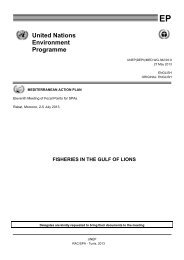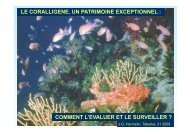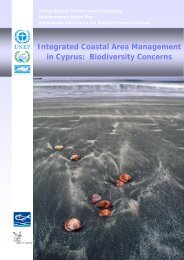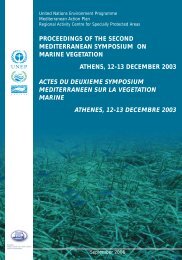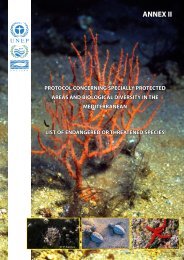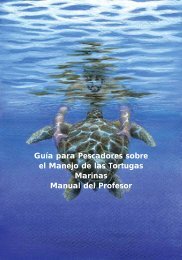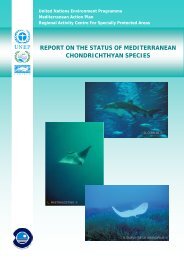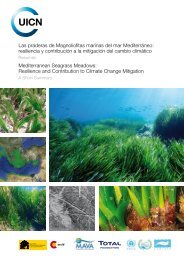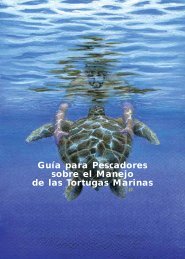Plan d'Action pour la conservation des espèces d'oiseaux inscrites ...
Plan d'Action pour la conservation des espèces d'oiseaux inscrites ...
Plan d'Action pour la conservation des espèces d'oiseaux inscrites ...
You also want an ePaper? Increase the reach of your titles
YUMPU automatically turns print PDFs into web optimized ePapers that Google loves.
GLOBALLY THREATENED SPECIES<br />
1. Dalmatian Pelican Pelecanus crispus<br />
A species occurring exclusively in major wet<strong>la</strong>nds, which breeds in<br />
countries of the Sarmatic region (essentially the Mediterranean and B<strong>la</strong>ck<br />
Sea); part of this popu<strong>la</strong>tion winters in the Mediterranean. The principal<br />
breeding areas (Albania, Greece and Turkey) and nesting areas (Albania,<br />
Greece, Syria and Turkey) are re<strong>la</strong>tively well known. To maintain the<br />
species’ status, it is a question above all of improving protection and<br />
management of nesting and wintering areas.<br />
2. Pygmy Cormorant Pha<strong>la</strong>crocorax pygmaeus<br />
Another Sarmatic species occurring in wet<strong>la</strong>nds, whose numbers have<br />
shown some signs of recovery in recent years, with an extension<br />
towards the west of the breeding area. The Action <strong>P<strong>la</strong>n</strong> estimates the<br />
breeding popu<strong>la</strong>tion in the Mediterranean at 2,500 pairs; other colonies<br />
exist in the Middle East. The principal nesting and wintering areas<br />
(Albania, Serbia, Greece and Turkey, with some pairs in Israel and Italy)<br />
are re<strong>la</strong>tively well known.<br />
3. Slender-billed Curlew Numenius tenuirostris<br />
One of the rarest species on the p<strong>la</strong>net, whose numbers probably do<br />
not exceed a hundred birds. Its nest has been found only once, in<br />
about 1917, in western Siberia: it undertakes an east-west migration<br />
across the B<strong>la</strong>ck Sea, then comes to winter in coastal areas of the<br />
Mediterranean, particu<strong>la</strong>rly in Greece, Italy, the Maghreb and Spain. It<br />
is difficult to recognise, since it is extremely simi<strong>la</strong>r to the Eurasian<br />
Curlew. Among the international measures taken for its <strong>conservation</strong>,<br />
the Agreement drawn up under the Convention on Migratory Species<br />
(CMS) should be mentioned.<br />
SPECIES OF ISLANDS AND CLIFFS<br />
Two groups of species are concerned here. On one hand there are the<br />
pe<strong>la</strong>gic sea-birds which only come to <strong>la</strong>nd during the nesting season;<br />
these are birds of the high seas, perfectly capable of spending the<br />
greater part of the year at sea, extremely well adapted to life at sea,<br />
but poorly adapted to walking on <strong>la</strong>nd, since their feet are p<strong>la</strong>ced so<br />
far back on their bodies; they <strong>la</strong>nd mainly at night, to avoid terrestrial<br />
predators. On the other hand, there are two species of raptor which<br />
nest on rocks and cliffs and pass the winter south of the Sahara.<br />
1. Cory’s Shearwater Calonectris diomedea<br />
Shearwaters are like miniature albatrosses; Cory’s Shearwater<br />
normally nests on rocky islets in the sea, in <strong>la</strong>rge colonies, some of<br />
which are well known, though those in the eastern Mediterranean<br />
and the Adriatic are less well known. In the Mediterranean there is an<br />
endemic sub-species C. d. diomedea; other sub-species occur in the<br />
At<strong>la</strong>ntic. The species is listed on Annex I of the 1979 European Union<br />
72




